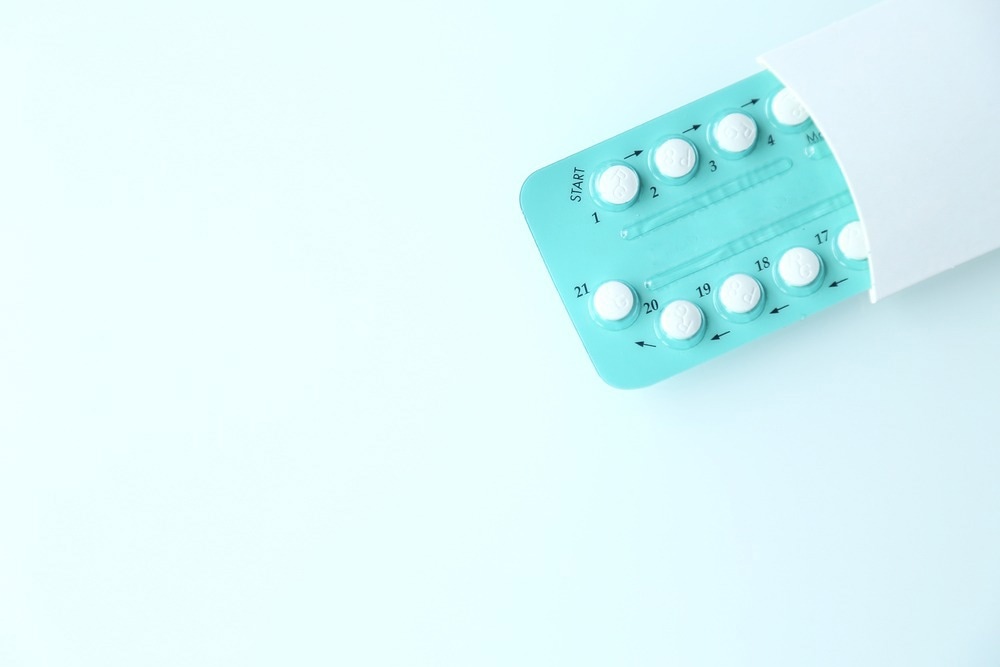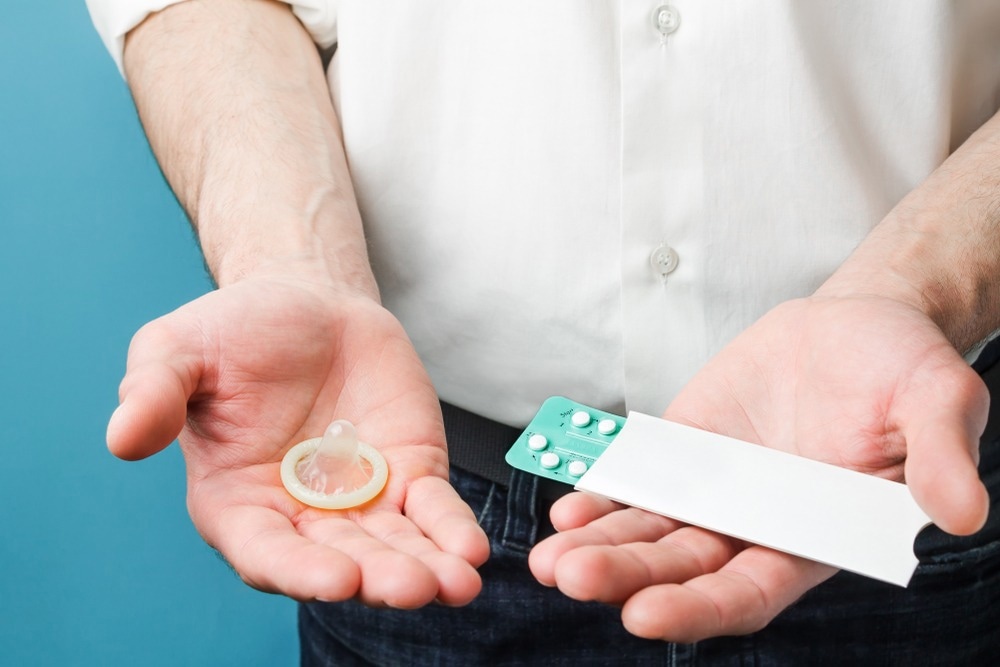Background
Hormonal methods of male contraception
Non-hormonal methods of male contraception
Conclusions
References
Further reading
The responsibility for contraception has generally fallen on women since the development of birth control pills in the 1950s, with only vasectomy presented as a realistic option for men outside of physical devices such as condoms. The production of an equivalent contraceptive pill for men has been less forthcoming, with issues relating to reversibility and safety. Public demand for a male alternative is high, and surveys indicate that most men would favor greater control over contraception.

Image Credit: Aleksandra Berzhets/Shutterstock.com
Background
Where the female reproductive cycle is dependent on hormonal levels that can be manipulated to stall in a particular phase, the male contraceptive pill would be required to either halt the production of sperm, prevent sperm from leaving the body, seriously incapacitate sperm so that they are incapable of inseminating an egg, or otherwise make fertilization impossible through some other small-molecule, non-hormonal mechanism.
Several pioneering attempts at one or more of these mechanisms have been attempted in recent decades, though often requiring regular injection rather than being in pill form, which is inconvenient for long-term and widespread use. Several of the most prominent and promising examples of male contraceptives under investigation will be explored here, and the future prospects for a male contraceptive pill will be discussed.
Hormonal methods of male contraception
Sperm and testosterone production is performed in the testes via Sertoli and Leydig cells, both of which are stimulated into production by various hormones originating from the hypothalamus and pituitary glands.
High circulating testosterone inhibits the production of gonadotropin-releasing hormone and gonadotropins from the hypothalamus and pituitary gland, respectively, forming a negative feedback loop that keeps hormonal levels and sperm generation relatively constant. Interruption of this cycle by administration of androgen receptor inhibitors that block hormone production in the hypothalamus and pituitary gland can therefore suppress sperm and testosterone synthesis in the testes, effectively acting as a contraceptive.
However, testosterone is involved in various bodily functions besides sperm production, and in particular, individuals with low testosterone experience loss of muscle mass, low libido, and frequent depression. Co-administration of synthetic hormone drugs such as progestin can support the peripheral actions of testosterone, however, potentially alleviating the negative side effects of exogenous androgen inhibitors.
Efficacy trials utilizing combined androgen inhibitor and progestin administration have been performed in the form of a monthly injectable, subdermal implant, and combined transdermal gel and pill, each demonstrating good efficacy in reducing sperm levels to lower than 1 million per mL in the majority of participants.
How a male contraceptive pill could work | John Amory
Based on the number of pregnancies occurring during the study periods, the medication appears as effective as the female contraceptive pill, though widely reported weight gain, acne, mood swings, and similar side effects were noted. Interestingly, differences in efficacy dependent on participant ethnicity were also found during these studies, suggesting that a personalized medicine approach may be required to tailor the male contraceptive pill optimally.
Further, even with maximal safe dosing, many men still persistently produce sperm at low levels by this method, and thus several other hormonal routes are under exploration. Various modifications to the molecular structure of the anabolic steroid nandrolone have proven effective in supporting androgenic body composition while activating androgen receptors and suppressing endogenous testosterone production.
Non-hormonal methods of male contraception
Several non-hormonal methods of male contraception are also under exploration, involving the targeting of Sertoli or Leydig cells to inhibit sperm production, direct disablement of sperm, blocking of the vas deferens, or other similar routes.
The latter is achieved by injecting a polymer into each vas deferens that physically blocks the passage of sperm and also induces a local pH reduction, disrupting sperm head polarity. The procedure can then be reversed by injecting sodium bicarbonate to dissolve the plug, resuming normal sperm function. This procedure has been explored in India over the last few decades. It has proven effective in imparting temporary sterility for as long as a year, though long-term efficacy and safety have yet to be established.
Another potential method of male contraception is by attachment of molecules to the outer surface of sperm, which reduces their viability. EPPIN is a sperm-specific surface protein involved in binding with seminal plasma protein. Thus, anti-EPPIN antibodies that block this site limit sperm motility and forward progression.

Image Credit: TanyaJoy/Shutterstock.com
Human trials utilizing this method are yet to occur, as issues relating to long-term safety and effective antibody delivery are still under question. Similarly, indenopyridines target Sertoli cells and disrupt their microtubule structure, leading to apoptosis, and have been explored both in vitro and in vivo. Animal studies provide a conflicting view of long-term reversibility, however, with mixed reports of both poor and quick returns to sperm count and motility. Thus human studies are yet to occur.
Lonidamide and retinoic acid receptor antagonists also act by disrupting Sertoli cell function, the former also by direct apoptotic action, being a chemotherapeutic drug normally administered in treating cancer. Vitamin A metabolizes to retinoic acid, which upon binding to retinoic acid receptors in Sertoli cells, aids in regulating gene expression leading to spermatogenesis.
Indeed, extreme vitamin A deficiency can be a leading factor in sterility amongst males, and thus blocking the retinoic acid receptor could induce temporary infertility without any long-last or hormonal side effects. One of the primary acute side effects reported by retinoic acid receptor antagonists or retinoic acid biosynthesis inhibitors is severe vomiting and nausea following the co-consumption of alcohol. After cessation of treatment, sperm production reportedly returns to normal within several months.
Conclusions
Interest in the generation of a safe, reliable, and convenient male contraception has peaked in recent years, and several promising clinical studies are underway that exploit various hormonal and non-hormonal mechanisms.
Importantly, a variety of choices in terms of drug mechanism of action and administration route is essential in promoting widespread adoption, avoiding some of the mistakes made in previous decades while promoting contraceptive medication to women without a personalized medicine approach.
References
- Thirumalai, A., & Page, S. T. (2019). Recent Developments in Male Contraception. Drugs, 79(1), 11–20. https://doi.org/10.1007/s40265-018-1038-8
- Long, J. E., Lee, M. S. & Blithe, D. L. (2019). Male Contraceptive Development: Update on Novel Hormonal and Nonhormonal Methods. Clinical Chemistry, 65(1).
- Yuen, F., Nguyen, B. T., Swerdloff, R. S., & Wang, C. (2020). Continuing the search for a hormonal male contraceptive. Best Practice & Research Clinical Obstetrics & Gynaecology, 66, 83–94. https://doi.org/10.1016/j.bpobgyn.2020.02.003
Further Reading